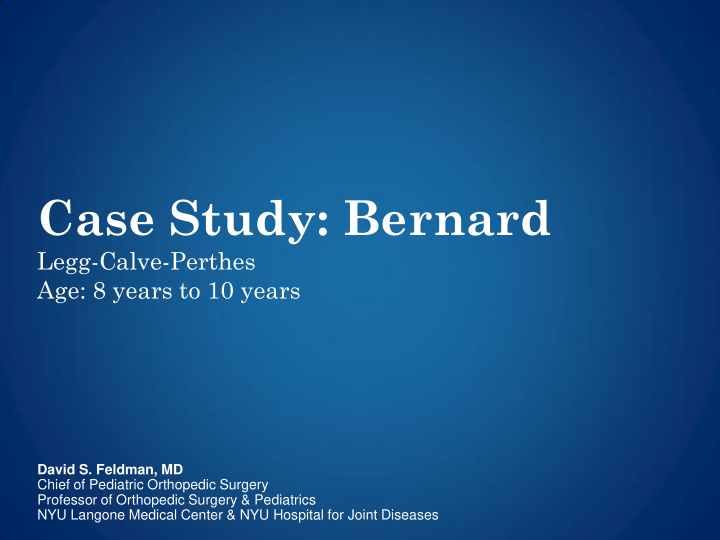



Case Study: Bernard Legg-Calve-Perthes Age: 8 years to 10 years David S. Feldman, MD Chief of Pediatric Orthopedic Surgery Professor of Orthopedic Surgery & Pediatrics NYU Langone Medical Center & NYU Hospital for Joint Diseases
BACKGROUND
At the age of 8 years and 2 months, Bernard’s pediatrician diagnosed him with Legg-Calve-Perthes disease of the right hip. He was placed on crutches and began physical therapy.
Bernard was then referred to two hip specialists, one recommended an osteotomy and therapy while the other thought an osteotomy was too aggressive when night bracing and crutches could be sufficient.
Bernard visited me for a third opinion on possible treatment options when he was 8 years and 3 months old.
DIAGNOSIS
Bernard had pain in his right hip but felt no pain and had full range of motion in his left hip. His knees and ankles were normal and there was no family history of hip problems.
I noticed that Bernard was limping to avoid standing on his right leg when he walked (antalgic gait). In addition, while a left hip’s normal range of motion is 45 degrees, Bernard’s was limited to 25 degrees (abduction) and he was unable to internally rotate his hip.
X-rays provided by his parents showed Legg-Calve-Perthes in the right hip that had increased in severity over time.
TREATMENT
Intraoperative Arthrogram with Interpretation
Bernard underwent an arthrogram shortly before surgery to determine if the best course of action would have been an osteotomy or joint distraction (arthrodiastasis). His hip was injected with a dye to contrast the parts of his hip and then a series of X-rays were taken.
Bernard’s arthrogram showed a correction of more than twenty degrees was needed. In addition, treatment began later in the process than usual and his femoral head was severely deteriorated. As a result, it was decided that Bernard would undergo arthrodiastasis.
An osteotomy is the best option if an arthrogram shows a correction of twenty degrees or less is needed. However, arthrodiastasis is the best option if a correction of over twenty degrees is needed because an osteotomy is insufficient in such cases.
Right Hip Arthrodiastasis with Multiplanar EBI Distraction External Fixator Applied
Arthrodiastasis involves separating the parts of the hip joint while keeping ligaments and tendons intact. The procedure allows the components of the hip to be properly spaced and aligned. An EBI external fixator is a medical device that is used to hold / guide bones into the correct position and proper alignment.
Post Op Treatment
Daily antibiotics to avoid infection. Physical therapy two times per week to improve range of motion in knee and hip. Monthly follow-up appointments to check pin sites for signs of infection and progression of the right hip’s rehabilitation. Bernard’s external fixator was removed six months after surgery but he continued physical therapy to strengthen his hip and improve its range of motion.
Results
Exams and radiographs during follow-up appointments revealed that Bernard’s hip was well positioned and there was an improvement in the hip’s range of motion. Over time his femoral head began to heal and take on a healthy rounded shape. However, he continued walking with a limp.
CONCLUSION
By the age of ten, Bernard had normal range of motion and no pain in his hip. He is now running and walking without limitations.
David S. Feldman, MD Pediatric Orthopedic Surgeon www.davidsfeldmanmd.com
Recommend
More recommend